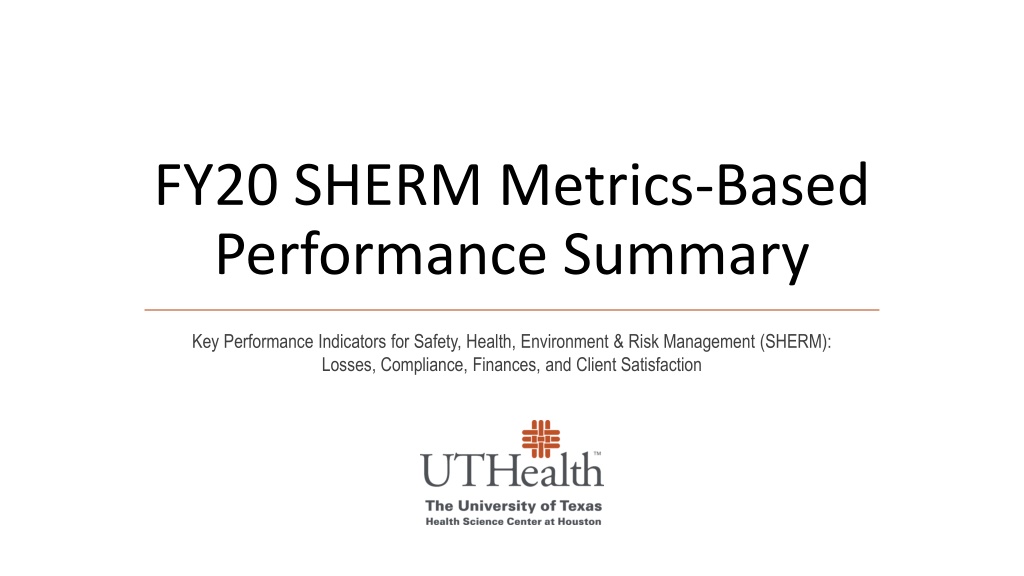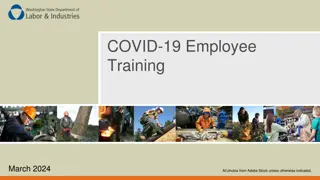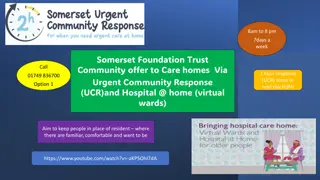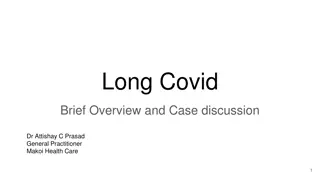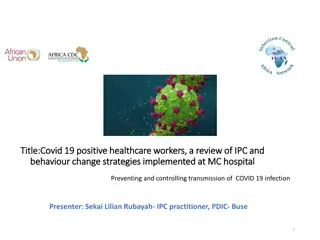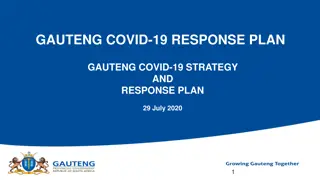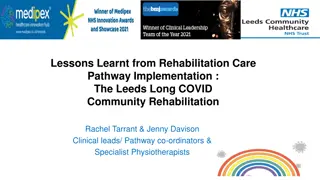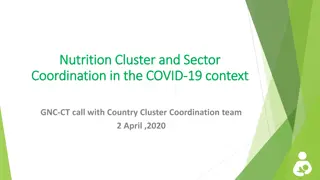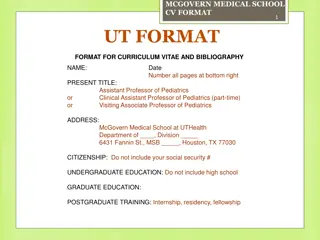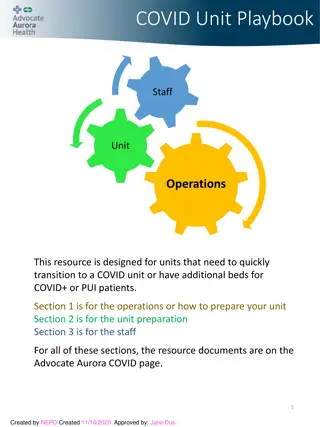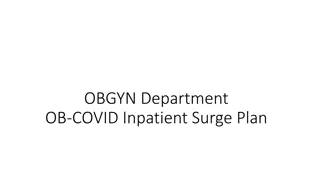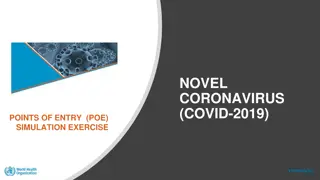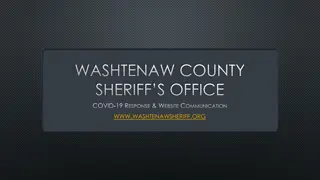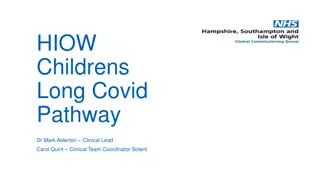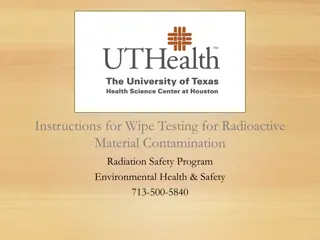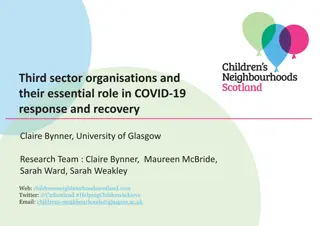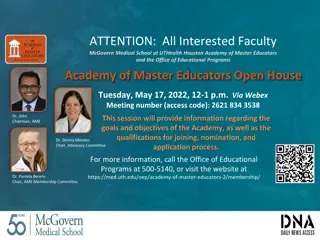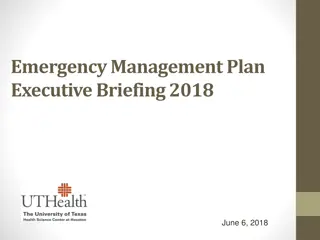SHERM's Impact and Response to COVID-19 at UTHealth
COVID-19 pandemic significantly influenced departmental operations at UTHealth, with services either increasing, maintaining, or deferring. SHERM staff, essential personnel working on-campus, adapted to high workloads and participated in furlough programs. Biosafety measures, travel restrictions, remote work, PPE shortages, and training were key responses to ensure safety and compliance.
Download Presentation

Please find below an Image/Link to download the presentation.
The content on the website is provided AS IS for your information and personal use only. It may not be sold, licensed, or shared on other websites without obtaining consent from the author. Download presentation by click this link. If you encounter any issues during the download, it is possible that the publisher has removed the file from their server.
E N D
Presentation Transcript
FY20 SHERM Metrics-Based Performance Summary Key Performance Indicators for Safety, Health, Environment & Risk Management (SHERM): Losses, Compliance, Finances, and Client Satisfaction
UTHealth Institutional Missions and SHERM s Role, Contributions UTHealth institutional missions: Teaching Research Service Service to the Institution (SHERM s primary role) 4 Key Performance Indicators (KPI) of safety services provided Service to the Community SHERM also contributes to the other key institutional missions as well
COVID-19 Pandemic Impacts Throughout this year s annual report, impacts to our departmental operations and services due to COVID-19 are specifically highlighted and addressed Many services dramatically increased Normal operations and services were maintained Some services reduced or were deferred until a later time period As essential personnel, SHERM staff remained on campus during the entirety of the pandemic to serve the institution Despite the incredibly high work load, all SHERM staff participated in the mandatory one day per week vacation / furlough program for the full sixteen week period
Summary of COVID-19 Timeline and Events Biosafety Program monitored outbreak situation starting in December 2019 Interim policies regarding travel restrictions and return to campus developed to address escalation of outbreak situation (in cooperation with Student and Employee Health) Communications distributed to UTHealth campus Very frequent Incident Command calls with UTHealth leadership Signage posted throughout UTHealth buildings regarding basic public heath precautions Social distancing, thermal scanning, travel history, health history implemented School and workplace closures in alignment with Governor s executive orders Working and learning remotely considerations and issues Issues regarding child coverage (closure of UTHealth child care center) PPE shortages, sourcing issues, and establishment of PPE Task Force; N95 reprocessing center Respiratory fit testing and training for over 4X normal volume of individuals Adjusting SHERM workloads to accommodate for furlough days but maintaining regulatory compliance and service levels Implementation of additional housekeeping disinfection and cleaning protocols On site consultations for schools, departments, and units returning to campus Training regarding PPE use, particularity for students interacting with patients during ongoing periods of widespread community transmission Increase in IBC protocol submittals and reviews and much, much more
SHERMs Four Key Performance Indicators (KPI) for Safety Services to the Institution KPI #2 Compliance With external agencies With internal assessments KPI #1 Losses Personnel Property KPI #3 Finances Expenditures Revenues KPI #4 Client Satisfaction External clients served Internal department staff
KPI #1: Losses Personnel Numbers of first reports of injury submitted by employees, residents, students Number of reported employee injuries and illnesses requiring medical treatment Workers Compensation Insurance experience modifier Property Losses incurred and covered by UTS Comprehensive Property Protection Program Losses incurred but covered by outside party Losses retained by UTHealth
Number of First Reports of Injury, by Population Type, FY01 FY20 (estimated total population = 14,595; employees: 9,278; students: 5,317) 800 Medical Residents transitioned to become Employees Oversight by SHERM 700 NOTE: UTHealth employee headcount increased 58% between FY14 to FY20 600 500 Number of First Reports Total n= 419 Employees n= 388 400 300 200 100 Students n= 31 Residents n= 0 0 FY01 FY02 FY03 FY04 FY05 FY06 FY07 FY08 FY09 FY10 FY11 FY12 FY13 FY14 FY15 FY16 FY17 FY18 FY19 FY20 Fiscal Year
Total Number of Employee First Reports of Injury and Subset of Compensable Claims Submitted to UT System, FY03 to FY20 Medical Residents transitioned to become Employees 400 Oversight by SHERM 350 Number of reports with no medical claims 300 250 200 150 100 Number of reports with medical claims 50 0 FY03 FY04 FY05 FY06 FY07 FY08 FY09 FY10 FY11 FY12 FY13 FY14 FY15 FY16 FY17 FY18 FY19 FY20 *Increase in UTP clinics has resulted in greater risk of injury due to higher clinical injury exposures
Annual UTHealth Incidence Rate of Reported Employee Injuries and Illnesses Compared to National Hospital and University Rates (national data source: US Bureau of Labor Statistics) Annual Reported Injury/Illness Rates 8 7 Injury/Illness Rate per 100 Full Time Workers 6 Hospitals NAICS 622 5 4 3 Universities NAICS 6113 2 1 UTHealth 0 FY07 FY08 FY09 FY10 FY11 FY12 FY13 FY14 FY15 FY16 FY17 FY18 FY19 FY20
Workers Compensation Insurance Premium Experience Modifier for UT System Health Institutions Fiscal Years 03 to 20 (premium rating based on a three year rolling average as compared to a baseline of 1.00) 0.60 Medical Residents transitioned to become Employees Oversight by SHERM 0.50 0.40 0.30 0.20 UTHSCT (0.193) UTMB (0.122) UTHSCSA (0.100) UTSWMCD (.091) UTHSCH (.073) 0.10 UTMDACC (0.043) 0.00 2003 2004 2005 2006 2007 2008 2009 2010 2011 2012 2013 2014 2015 2016 2017 2018 2019 2020 Fiscal Year
FY20 Retained Property Losses Retained Losses (inclusive of insurance deductibles) Retained Loss Cost Summary by Peril (Total FY20 retained losses = $10,100) Type Location Date Cost Fire Auto Water Housing 9/2019 $1,000 Water Housing 9/2019 $250 Water Housing 9/2019 $1,000 T.S. Imelda Various 9/2019 $1,000 Water SPH 12/2019 $200 Water UCT 1/2020 $1,000 Water UCT 3/2020 $2,000 Fire Housing 6/2020 $150 Misc. Misc. ------ $3,500 TOTAL $10,100 Water Losses incurred and covered by third party Auto-------------11/2019 $3,179 Auto --------------3/2020 $1,287 Auto--------------4/2020 $7,630 Auto--------------4/2020 $5,991 Auto--------------4/2020 $2,473 Losses incurred and covered by UTS insurance N/A
UTHealth Total Property Retained Loss Summary by Peril and Value, FY06 to FY20 $900,000 NOTE: FY17 & FY18 does not include Harvey losses data not yet available $800,000 $700,000 $600,000 $500,000 Lightning/ Fire* $400,000 Water Hurricane $300,000 $200,000 $100,000 $0 FY06 FY07 FY08 FY09 FY10 FY11 FY12 FY13 FY14 FY15 FY16 FY17 FY18 FY19 FY20 *Lightning strike caused fire damage at student housing totaling $978,000 loss
COVID-19 Impacts on Losses Employees, residents, and students testing positive during COVID-19 pandemic impacting their ability to work or learn Each case resulted in needs for contact investigations, disinfection/decontamination of work spaces, and lost work time during quarantine period 34 individuals providing clinical care submitted First Reports of Injuries indicating they sustained a workplace COVID-19 exposure Total number of First Reports of Injury plummeted overall during fiscal year due to significant number of individuals working or learning remotely Anticipating possible increase in First Reports of Injury for issues sustained off campus while working/learning remotely (e.g. ergonomics, etc.), but this has not occurred yet
FY21 Planned Actions - Losses Personnel Closely monitor increase in reported employee injury events (largely from the clinic setting) determine root cause and implement preventive measures Evaluate slip, trip, and fall data to determine possible trends or locations; provide interventions to prevent recurrence where possible Continue to focus on transition of medical residents who became employees on July 1, 2019 to contain costs associated with bloodborne pathogens exposures Continue to support individuals as they return to campus during the COVID-19 pandemic situation to ensure health and safety of all campus stakeholders Property Continue with successful efforts to educate faculty and staff about common perils causing losses (water, power interruption, and theft), simple interventions Develop additional predictive methods for prompt recovery after losses occur, specifically estimated length of time to recovery Continue to refine and improve oversight of UTP property loss prevention, mitigation, and insurance program
KPI #2: Compliance With external agencies Regulatory inspections; other compliance related inspections by outside entities With internal assessments Results of EH&S routine safety surveillance activities
External Agencies Inspections n= 24 Date Agency Findings Status 1 September 3, 2019 Texas Department of State Health Services Radiation Control No items of non-compliance (UTHealth, Dental Surgeons at Scurlock, X-ray R10908, Site 027, Unannounced) Inspection file closed 2 November 18, 2019 Texas Department of State Health Services Radiation Control No items of non-compliance (UT Physicians, Fall Creek Ortho clinic, X-ray R26367, Site 038, Unannounced) Inspection file closed 3 December 5, 2019 Texas Department of State Health Services Radiation Control No items on non-compliance (UT Physicians, RBJ Sugarland Ortho clinic, X-ray R26367, site 022, Unannounced) Inspection file closed 4 Inspection file closed December 20, 2019 Texas Department of State Health Services Radiation Control EPE alleged late, requested rescind due to miscalculation by inspector (UT Physicians, SE Astoria Ortho clinic, X-ray R26367, site 009, Unannounced) 5 January 30, 2020 Texas Department of State Health Services Radiation Control No items on non-compliance (UT Physicians, Cypress Ortho, X-ray R26367, Site 035, Unannounced) Inspection file closed
External Agencies Inspections n= 24 Date Agency Findings Status 6 Inspection file closed January 30, 2020 Texas Department of State Health Services Radiation Control No items of non-compliance (UT Physicians, Bayshore Multispecialty clinic, Radioactive License L05465, site 004) 7 Texas Department of State Health Services Radiation Control February 26, 2020 Inadequate QA/QC procedures (UTHealth, Dental GPR at UTPB Suite 300, X-ray R10908, Site 016, Unannounced) Inspection file closed 8 All findings addressed and corrected; inspection file closed April 27- May 1, 2020 Centers for Disease Control and Prevention, Federal Select Agent Program (conducted virtually due to COVID-19) Several minor findings and recommendations for improvement 9 Inspection file closed May 18, 2020 Texas Department of State Health Services Radiation Control No items of non-compliance (UT Physicians, Katy Ortho clinic, X-ray R26367, Site 000, Virtual during COVID-19 precautions) 10 Inspection file closed May 18, 2020 Texas Department of State Health Services Radiation Control No items of non-compliance (UT Physicians, Bellaire MIST clinic, X-ray R26367, Site 007, Virtual during COVID-19 precautions)
External Agencies Inspections n= 24 Date Agency Findings Status 12 Inspection file closed May 18, 2020 Texas Department of State Health Services Radiation Control No items of non-compliance (UT Physicians, SW Ortho (Jones) clinic, X-ray R26367, Site 012, Virtual during COVID-19 precautions) 13 May 19, 2020 Inspection file closed Texas Department of State Health Services Radiation Control No items of non-compliance (UT Physicians, Memorial City Ironman clinic, X-ray R26367, Site 013, Virtual during COVID-19 precautions) 14 May 19, 2020 Texas Department of State Health Services Radiation Control No items of non-compliance (UT Physicians, Memorial Westside Bone & Joint clinic, X- ray R26367, Site 017, Virtual during COVID- 19 precautions) Inspection file closed 15 Texas Department of State Health Services Radiation Control No items of non-compliance (UT Physicians, Cinco Ranch clinic, X-ray R26367, Site 015, Virtual during COVID-19 precautions) May 19, 2020 Inspection file closed 16 Texas Department of State Health Services Radiation Control No items of non-compliance (UT Physicians, Woodlands Ortho clinic, X-ray R26367, Site 020, Virtual during COVID-19 precautions) May 19, 2020 Inspection file closed
External Agencies Inspections n= 24 Date Agency Findings Status 17 Inspection file closed May 19, 2020 Texas Department of State Health Services Radiation Control No items of non-compliance (UT Physicians, Bay Area Pedi clinic, X-ray R26367, Site 026, Virtual during COVID-19 precautions) 18 Inspection file closed Texas Department of State Health Services Radiation Control No items of non-compliance (UT Physicians, HOSP Bellaire clinic, X-ray R26367, Site 028, Virtual during COVID-19 precautions) May 19, 2020 19 Inspection file closed Texas Department of State Health Services Radiation Control No items of non-compliance (UT Physicians, Neuroscience Spine clinic, X-ray R26367, Site 040, Virtual during COVID-19 precautions) May 19, 2020 20 Inspection file closed Texas Department of State Health Services Radiation Control No items of non-compliance (UT Physicians, Pearland Ortho 2 clinic, X-ray R26367, Site 041, Virtual during COVID-19 precautions) May 27, 2020 21 Inspection file closed Texas Department of State Health Services Radiation Control No items of non-compliance (UT Physicians, TMC Ortho clinic at Suite 2250, X-ray R26367, Site 030, Virtual during COVID-19 precautions) May 27, 2020
External Agencies Inspections n= 24 Date Agency Findings Status 22 Inspection file closed Texas Department of State Health Services Radiation Control No items of non-compliance (UT Physicians, Pearland Ortho clinic, X-ray R26367, Site 029, Virtual during COVID-19 precautions) May 27, 2020 23 Inspection file closed Texas Department of State Health Services Radiation Control No items of non-compliance (UT Physicians, Sugarland ortho clinic, X-ray R26367, Site 011, Virtual during COVID-19 precautions) May 27, 2020 24 Inspection file closed Texas Department of State Health Services Radiation Control No items of non-compliance (UTHealth, Broad license on South Campus (BBSB, SCRB3 and SOD) Radioactive material license L02774, Site 007, in person inspection with different clinical & research COVID-19 precautions and procedures) August 11, 2020
Non-Routine External Compliance Ensuring normal compliance measures remained in place during COVID- 19 shutdown and ongoing pandemic situation Adjusting operations to meet regulatory compliance variances issued by various regulatory authorities during COVID-19 shutdowns (e.g. oversight of radioactive materials; respiratory protection requirements due to severe global supply shortages such as reuse or reprocessing of protective equipment and temporary exemption from annual fit testing requirements; etc.) Adaptation to new virtual format utilized for regulatory inspections in lieu of onsite inspections during the COVID-19 pandemic
Routine Internal Compliance Assessments 4,358 workplace assessments documented (decrease of 30% compared to FY19 due to COVID-19 impacts) Progression of routine surveillance program emphasis: labs, clinics, building fire systems, mechanical and non-lab spaces 1,316 deficiencies identified (70% in non-lab spaces) 390 of these deficiencies now corrected to date (represents a decreased efficiency in correcting deficiencies due to challenges of COVID-19 impacts) EHS will continue to focus on assisting with correction of remaining 926 deficiencies Some lab personnel not present onsite to help correct local issues Clinical staff focused on COVID-19 issues and patient care as a priority Working with FPE to track and report progress and reporting progress to appropriate safety committees 12,641 individuals provided with required safety training (increase of 49% due to COVID-19 impacts) Increase from 1,200-1,300 individuals on average per year to 5,500 individuals trained and fit tested for respiratory protection Clinical based students (e.g. McGovern Medical School, Cizik School of Nursing, School of Dentistry) provided with COVID-19 awareness and PPE training Drastic increase in participation in online safety training modules (primarily refresher lab and clinic safety training) Students accessing online safety training content in lieu of in-person training As a result of software upgrades, there is now improved reporting of online safety training between EHS Assistant and HR Learning Management System (Learn 2 Succeed) 70% of PIs have submitted chemical inventories for filing in SHERM database
Non-Routine Internal Compliance Onboarding of medical residents as employees which included termination of Texas Mutual WCI coverage and switching to UT System WCI oversight Water quality testing conducted in all UTHealth building locations following City of Houston water boil event due to major water main break to ensure safety of water supply (February 2020) Safety oversight of TRB major construction projects at UCT, MSB, and SPH; plus oversight of JJL renovations, new C3 project, and future TMC3 project
Non-Routine Internal Compliance COVID-19 related challenges: Respiratory protection program compliance due to COVID-19 pandemic and the resulting severe global supply shortages Over 5,500 individuals fit tested and trained by SHERM during FY20 (under normal circumstances average is 1,200 1,300 individuals) Waiver of annual fit testing requirement per OSHA allowance how do we maintain annual compliance for over 4X the normal average number of individuals going forward once this waiver is lifted? Expedited medical evaluations to ensure fit testing resources needed for Employee Health and Student Health to maintain this service going forward Limited reuse and extended use of PPE per CDC guidelines Validation and oversight of decontamination of N95s at MHH reprocessing center Sourcing and vetting of PPE from traditional and non-traditional vendors Return to campus on-site consultations for academic, research, and clinical settings to ensure congruency with COVID-19 protocols to ensure health and safety of all occupants Conducting routine fire drills while buildings primarily unoccupied Completing required tests and documentation for radioactive materials
FY21 Planned Actions - Compliance External compliance Continue to educate and prepare UTHealth & UTPhysicians clinics about State of Texas Radiation Control program who continue to conduct frequent unannounced x-ray inspections Consider participation in NNSA program to support decommissioning of Cesium irradiators and replacement with suitable X-ray irradiator alternatives Provide support for the forthcoming AAALAC accreditation site visit regarding occupational health and safety programs Providing necessary information and consultation for forthcoming SACSCOC site visit Internal compliance Develop efficiencies and strategy for long term management of respiratory protection program now that the demand has increased over four fold due to COVID-19 Continue aggressive routine surveillance program. Incorporate lessons learned from deficiency data into safety training to prevent recurrence. Focus on education of research and clinic personnel regarding controlled substances used and stored at UTHealth and UTP Continue to work with FPE to systematically address identified deficiencies and support current projects to address fire safety considerations Provide regular updates to appropriate safety committees Continue emphasis on lab inventories of hazardous materials Chemical inventories already a requirement Support biosafety awareness and inventory of biological agents and toxins within UTHealth laboratories
KPI #3: Finances Expenditures Program cost, cost drivers Revenues Sources of revenue, amounts
Campus Square Footage, SHERM Resource Needs and Funding (modeling not inclusive of resources provided for, or necessary for Employee Health Clinical Services Agreement) Total Assignable Square Footage and Research Subset Modeled SHERM Resource Needs and Institutional Allocations 5000000 $4,000,000 Research area (sf) 4500000 $3,500,000 4000000 Amount Not Funded $3,000,000 3500000 Contracts & Training 3000000 $2,500,000 WCI RAP Rebate 2500000 $2,000,000 2000000 $1,500,000 Institutional Allocation 1500000 $1,000,000 Non- research area (sf) 1000000 $500,000 500000 0 $0 FY13 FY14 FY15 FY16 FY17 FY18 FY19 FY20 FY13 FY14 FY15 FY16 FY17 FY18 FY19 FY20 Note: TNASF reported in FY18 & FY19 reduced due to accounting adjustment by FPE Source: FPE, Space Management
Annual Hazardous Wastes Volumes Generated (in pounds) (inclusive of all Hazardous Biological, Chemical, and Radioactive Waste Streams) Pounds *Note: Increase in radioactive wastes in FY19 related to compulsory decommissioning of cyclotron unit
Hazardous Waste Cost Obligation and Actual Disposal Expenditures (Inclusive of Biological, Chemical, and Radioactive Wastes) FY20 savings: $142,484
FY20 Revenues Service contracts UT Physicians $433,039 Note: UT Med Foundation WCI Administration discontinued due to transition of medical residents Continuing education courses/outreach Training, honoraria, peer reviews, and fit testing for non-UTHealth personnel $9,754 SHERM staff salary offsets from various research grants $30,000 Total $472,793 NOTE: Above equates to 18% of total SHERM budget for FY20
UT Physicians Service Agreement Professional Services Agreement: Agreement includes services such as training, radiation safety permitting & surveys, general clinic surveys, fire & life safety surveillance, waste management, emergency preparedness & response, IAQ evaluations, asbestos/mold monitoring, accident/incident investigations, CAP/CLIA quality control monitoring, etc. 5-year contract renewal due in April 2020, but extended to August 31, 2020 (at current annual rate of $427,693) to allow for transition to UTHealth / UTPhysicians MOU on Sept 1, 2020 Separate contract to oversee UTP property insurance programs also extended until August 31, 2020 until it could be folded in with UTHealth / UTPhysicians MOU Challenges Continued growth and rapid expansion of clinical locations and services Dramatic increase in manpower requirements for CAP/CLIA oversight and compliance, waste collection, occupational health services, training, etc. Emergency management for UTP clinics in different geographic locations
UT Physicians Service Agreement UTHealth / UTPhysicians MOU Discontinued SHERM Professional Services Agreement and transitioned to UTHealth / UTPhysicians MOU at the request of UTHealth leadership on Sept 1, 2020 Combination of safety, insurance, and occupational health services under one contract Current rate is now $800,000 annually for all services combined Future Growth 1 FTE planned for Hospital & Clinic Safety Program to primarily assist with CAP/CLIA oversight and compliance, respiratory fit testing for clinicians, etc. 1 FTE planned for Risk Management & Insurance Program to primarily assist with additional responsibilities related to loss prevention and insurance oversight for UTP, as well as to bolster emergency preparedness and management
Safety Support to UTHealth / UTPhysicians Clinics UTPhysicians Clinics: UTP clinic locations (n=118) Note: 12 pending new locations for FY21 UTP timeshare locations (currently ~30) UTHealth Clinics: UT Health Services Clinic (Employees and Medical Residents) UT Student Health Services Clinic SOD dental clinics (n=6) Neurosciences (n=11) WIC clinics (n=6)
FY21 Planned Actions - Financial Expenditures Continue aggressive hazardous waste minimization program to contain hazardous waste disposal costs Focus on regulated medical waste generation reduction in labs and clinics due to 30% increase experienced during recent (Sept 1, 2019) renewal of UT System-wide contract Fees increase significantly each fiscal year for each point of collection, so primary focus is on minimizing volumes and maximizing efficiency to reduce stop frequencies Continue to lobby for dedicated funding for Occupational Health Clinical Services Agreement because of impending discontinuance of UTS WCI RAP Revenues UTHealth / UTPhysicians MOU now includes occupational health allocation of $138,700 Continue with service contracts and community outreach activities that provide financial support to supplement institutional funding, including enhancing virtual training capabilities Continue to participate in various research grant projects which allow for staff salary offsets Continued receipt of WCI RAP fund allocations in FY21 ($160,721), but program may terminate at any point
FY21 Challenges - Financial Current Financial Challenges Continued support for 5,500 individuals now enrolled in respiratory protection program due to COVID-19 Fit testing and training; sourcing of N95s and other PPE appropriate to protect workers and students from COVID-19 exposure Anticipate significant increase in retained loss medical expenses due to transition of UT Medical Foundation residents to UT System workers compensation policy upon becoming UTHealth employees Additional manpower needs, primarily in OSFP (to support JJL and C3 projects, as well as forthcoming TMC3 project) and Hospital and Clinic Safety (to support ongoing clinical growth) Potential additional FTE in FY21 to serve C3 once completed Current shortfall in funding for Occupational Health Program $450,000 currently necessary to run program, increases anticipated due to recent medical resident transition WCI RAP funds being used to support program, but these funds may not be issued again in future $138,700 now coming from UTHealth / UTPhysicians MOU to help support Occupational Health Program
KPI #4: Client Satisfaction External clients served Results of Client Satisfaction Survey for UT Police department Internal department staff Summary of ongoing staff professional development activities
Client Feedback Focused assessment of a designated program aspect performed annually: FY03 Clients of Radiation Safety Program FY04 Overall Client Expectations and Fulfillment of Expectations FY05 Clients of Chemical Safety Program Services FY06 Clients of SHERM Administrative Support Staff Services FY07 Feedback from Employees and Supervisors Reporting Injuries FY08 Clients of Environmental Protection Program Services FY09 DMO/ASL Awareness Survey of Level of Informed Risk FY10 Clients of Biological Safety Program Services FY11 Feedback on new UTHealth Alert emergency notification system FY13 Clients of HCPC Safety Program Services FY14 Student Perception Survey question regarding safety program FY15 Clients of Occupational Safety & Fire Prevention program services FY16 Clients of HCPC Safety Program Services (re-evaluation of services since 2013 implementation) FY17 Area Safety Liaisons FY18 Clients of UTPhysicians Safety Program Services FY19 UTHealth Safety Committee Members (Institutional Biosafety, Chemical Safety, & Radiation Safety Committees) FY20 UT Police at Houston
Internal Department Staff Satisfaction Continued support of ongoing academic pursuits leverage unique linkage with UT SPH for both staff development and research projects that benefit the institution Weekly continuing education sessions on a wide variety of topics conducted continuously via virtual format during COVID-19 Safety Geek of the Week staff recognition award for superior service delivery Participation in the delivery of UT SPH continuing education course offerings Participation in various UT SPH academic courses Adjunct academic appointments in UT SPH EOHS department for doctorally-prepared staff (n=4) Participation on several health and safety related grants through UT SPH Membership, participation in professional organizations Annual conduct of SHERM Mentoring Day where any interested staff member can meet with the VP SHERM to discuss professional development plans and seek advice, suggestions
FY21 Planned Actions Client Satisfaction External Clients Continue with customer service approach to operations Collect data for meaningful benchmarking to compare safety program staffing, resourcing, and outcomes Interface with CLAMC will be focus for FY21 survey Internal Clients (departmental staff) Continue with routine professional development seminars Special focus on emerging issues: safety culture, insider threats, change management, technology in safety (digital safety), total worker health, cultural intelligence, communications, establishing relationships Continue with involvement in training courses and outreach activities continued focus on cross training Continue mentoring sessions on academic activities Continue 360o evaluations on supervisors to garner feedback from staff
Institutional Safety Service KPI Caveats Important to remember what isn t effectively captured by these metrics: Increasing complexity of research projects supported Increased collaborations and associated challenges Increased complexity of regulatory environment Impacts of construction both navigation and reviews The pain, suffering, apprehension associated with any injury every dot on the graph is a person The things that didn t happen
SHERM Contribution to the Community Service Institutional Mission Safety, insurance, and occupational health support to UT Physicians clinical operations Staff membership on local safety committees: Delivery of professional continuing education courses through UT SPH Institutional Biosafety Committees (Rice University; University of Houston Downtown ) Radiation Safety Committees (Memorial Hermann Hospital) Participation in the leadership and management of professional associations by SHERM staff members American Biological Safety Association International Inclusive of peer reviewed journal (Applied Biosafety) Editorial Board Southern Biosafety Association (local affiliate of ABSA - International) State of Texas Chapter of the Health Physics Society American Academy of Health Physics Outreach education through invited lectures provided to local and national professional organizations Provision of subject matter expert interviews on safety-related topics to local and national media
SHERM Contribution to the Teaching Institutional Mission UT SPH academic instruction, student advising Several SHERM employees serve in adjunct faculty positions at SPH Guest lectures at other UTHealth schools (UT MS and GSBS) and other area institutions (TAMU, TWU, TSU, UHCL, UHD) Host student internships, practica. Advising for UT MS Scholarly Concentration students Continuing education courses through UT SPH Outreach education through courses with professional organizations (HPS, ABSA, CSHEMA, Eagleson Institute)
SHERM Contribution to the Research Institutional Mission NIEHS training grant and Ebola supplement (w/Dr. Rios, UT SPH) NIOSH evaluation of elastomeric respirators in the healthcare setting grant (w/ Dr. Pompeii, Baylor College of Medicine) Participation in other funded grants: NIOSH ERC SWCOEH TSU Health Physics Program - $11,000 COVID-19 related research collaborations: Dr. Amber Luong evaluating decontamination methods for N95 respirators Dr. Mary (Cindy) Farach Carson evaluating novel N95 respirator product Memorial Hermann Hospital N95 reprocessing center validation and management Advising and hosting students for research projects and associated publications: Zapata J.R., Stewart J., Kelly K.O., Taylor A.R., Martinez E.I., Amoako K., Gutierrez J.M., Emery R.J., Cheng S.Y., Patlovich S.J., Harvey M.C. A Cyclotron Decommissioning Radiological Assessment Exercise Performed by Student Mentees Underrepresented in the Radiation Safety Profession. Health Physics, in publication July 2020. Emery, R.J., Rios, J., Becker, Z.B., Haltiwanger, B., & Patlovich, S.J. Characterization of Work Settings in Which Biosafety Professionals Conduct Operations: Results from the First Survey of the Biosafety Analytics Initiative Survey Series. Applied Biosafety, Volume 25, Number 2, 2020. Pompeii L, Benavides E, Pop O, Rojas Y, Emery R, Delclos G, Markham C, Vellani K, Levine N. Workplace violence in outpatient physician clinics: a systematic review. Int. J. Environ. Res. Public Health 2020, 17(18), 6587; https://doi.org/10.3390/ijerph17186587 Le, AB, Lowe, JJ, Patlovich, SJ, Emery, RJ, Beam, EL, Strain, A, Vasa, A., Schwedhelm, S, Gibbs, SG. Chapter 8: High-Level Containment Care (HLCC) Unit Operations. In T. Cieslak, M. Kortepeter, J. Lawler, C. Kratochvil (Eds.), The University of Nebraska Medical Center Isolation & Quarantine Manual. Lincoln, Nebraska. University of Nebraska Press. 2019: 61- 86. Emery RJ. Gaining Support for Security Programs Through Communications and Data. In: Strategic Security Management: A Risk Assessment Guide for Decision Makers, Second Edition. Vallani KW, CRC Press, Boca Raton FL 2019:193 -198. Emery RJ, Charlton MA, Brown BJ, Patlovich S. Contemporary industrial hygiene considerations in the health care work setting. In: Patty s Industrial Hygiene, 7th Edition, in publication 2020.
Summary Various measures and metrics indicate that SHERM continues to meet its objective of maintaining a safe and healthy working and learning environment in a cost effective manner that doesn t interfere with operations, while also making active contributions to the institutional missions: Injury rates continue to be among the lowest within the UT System Despite continued growth in the research enterprise, hazardous waste costs aggressively contained Client satisfaction continues to be measurably high And while providing these services, SHERM also actively contributes to the teaching, research, and community service missions of the institution The major area of current institutional growth is in the clinical setting, so SHERM will need to adjust accordingly to support this enterprises The impending discontinuance of the UTS WCI Resource Allocation Program represents a challenge, especially for the Occupational Health program A successful safety program is largely people powered the services most valued by clients cannot be automated! SHERM resource needs will continue to be driven primarily by the square footage to which services are provided (total, lab and clinic square footage) and geographic distribution
